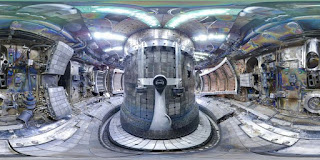Mimicking the Fury of the Sun for the Ultimate Clean Energy Fusion Reactor
Mimicking
the Fury of the Sun for the Ultimate Clean Energy Fusion Reactor
By E. Stanley Ukeni
Lately there seems to be a flurry
of news story about all kinds of new and potentially revolutionary advancements
in fusion technology. Sure we are all enthused about the possibilities being
offered by this amazing technology that offers the promise of the ultimate solution
to the world’s energy needs while helping militate against climate change.
But the reality is that the
science of creating a commercially viable fusion reactor is still lacking an
essential understanding of how the Stars that are scattered across the vast
expanse of the universe maintains a self-sustained fusion reaction, similar to
the process that is seamlessly occurring in our Sun. It would appear that the
sun has not given up all of its secrets after all—at least, not yet anyway.
My thinking is that, rather
than advancing the understanding of the intricacies of the fusion process,
scientists are merely making good strides in mastering the plasma containment
technology that is necessary for a safe and operational nuclear fusion reactor.
However, that is just the first
of two fundamental problems that they need to solve before any of the many
State and Corporate entities working on developing a viable nuclear fusion
reactor can claim any sort of revolutionary scientific breakthrough in fusion
science.
It is common knowledge that the
development of viable fusion technology has been constrained by the difficulty
that scientists are having in regulating the atomic reaction that is occurring
within the containment chamber of the reactor so that they can, in essence,
control the massive amounts of heat being released.
On a fundamental level, the
process of self-sustaining nuclear fusion reaction is achieved when heavy
hydrogen atoms (known as tritium and deuterium) are subjected to high pressures
and temperatures of approximately 150 million degrees Celsius (270 million
degrees Fahrenheit)—a temperature level that is supposedly hotter than what is
obtainable at the center of the sun.
The intense pressure and
temperature are needed to cause these subatomic particles to reverse their
natural tendency to resist and repulse one another. The effect of this is that
these ionic particles bonds together forming a new element helium. It at this
point that the fusion process occurs and an incredible amount of energy are
released—in theory, this process thus becomes self-sustaining.
In order to achieving this
level of pressure and temperature, whilst maintaining minimal thermal loss,
powerful heating instruments are needed—this is where the reactor technology
comes into play. Scientists devised an ingenious way to ensure that the reactor
sustains such an intense temperature without experiencing a thermal meltdown,
by ensuring that the super-heated plasma inside the reactor chamber is kept
away from the reactor walls.
To achieve this, they padded
the walls of the reactor chamber with advanced superconducting devices that can
generate strong magnetic fields—preferably, with minimum amount of power. Since
the super-hot plasma is an electrically-charged gas, it is kept away from the
walls of the reactor chamber by the magnetic fields.
The integrity of the magnetic
fields is sustained by both the electromagnets which line the reactor chamber
and by an electrical current that is generated by the heated plasma. This
ensures that the magnetic field which is meant to ensure that the plasma
particles and their energy output are repelled away from the reactor wall.
There are two major reasons, in
my lay opinion—and I’m sure it’s an opinion shared by experts in the field, why
scientists are still far from building a functional and commercially viable
fusion reactor.
The first is that fusion
reactors have not yet been able to generate more energy than it takes to
produce the temperatures required for a self-sustaining fusion process to
occur. This makes fusion technology, at its current stage of development,
commercially non-viable.
The second reason is the threat
to the structural integrity of the reactor chamber posed by runaway electrons. I
feel that this is an intrinsically dangerous problem for fusion reactor
technology—one that needs to be solved before fusion reactors can be considered
to be a safe alternative to conventional fission reactors.
So what are these runaway
electrons? You may ask. Well, we can sort of think of them as radicalized
electrons with extremely high energy from its interaction with potent electric
fields. Within the high pressure confines of a fusion reactor chamber, the
intensity and acceleration that these free-radical electrons are charged can
cause catastrophic damage to the reactor wall, as well as the exhaust regions—leading
to disastrous thermal meltdown of the reactor.
Many scientists have proffered
solutions to the problems of runaway electrons within the fusion chamber;
however, I am convinced that these solutions will precipitate other unforeseen
problems.
I am of the sense that the
solution to the fusion energy conundrum lies in the development of new science
to explain how the sun is able to maintain its cohesive mass while engaged in a
self-sustained fusion reaction process. This new discipline should take into
account the existence of a yet undiscovered particle-wave that harmonizes the
cascade of nuclear fusion.
I believe that astrophysicists
would have to peer even deeper into the sun’s interior to decipher what is
going on in there, if they hope to effectively replicate the actual particle(s)
responsible for regulating the behavior of runaway electrons inside the sun’s
core.
I was compelled to offer up
this opinion because I am of the conviction that in order to safely and
reliably control fusion plasma, scientists have to thoroughly understand its natural
properties—especially, those that are yet unknown, like the ‘Spectrion’
wave-particle.
Let’s be clear here, I am not
by any means trying to suggest that scientists diminish their current efforts
at continuing to develop fusion technology. On the contrary, I feel very
strongly that the promise of fusion energy—a potentially limitless and clean
source of electrical power generation, means that no effort should be spared in
actualizing this important technology. I hope that additional financial
resources are allocated to making this vital technology viable, in the near
future.
If you like this article, consider becoming a
supporter. Thank you.
Authored by E. Stanley Ukeni, ©
2017. All Rights Reserved. This material and other articles or stories posted
on this blog site may not be reproduced, published, broadcast, rewritten or
redistributed, in whole or in part, without prior expressed written permission
from the author, E. Stanley Ukeni.
You are invited to follow E.
Stanley Ukeni on twitter at; @EzStan . You’re equally invited to follow him on
google+. Oh yeah, don’t forget to subscribe to this blog Site. Thanks.
Photo
Credits: NASA; MIT; National Fusion Research Institute, Korea;





Comments
Post a Comment